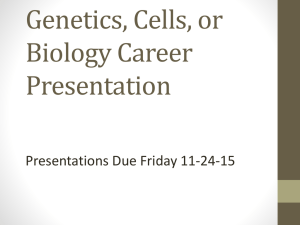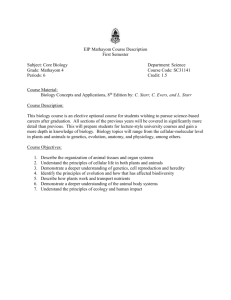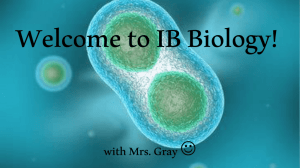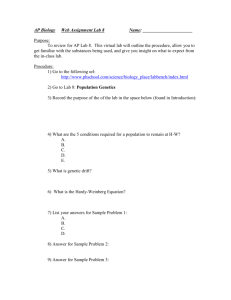Syllabus for A.P. Biology 2012 -Text: Campbell, Reece Biology 8 edition (*Text Chapters)
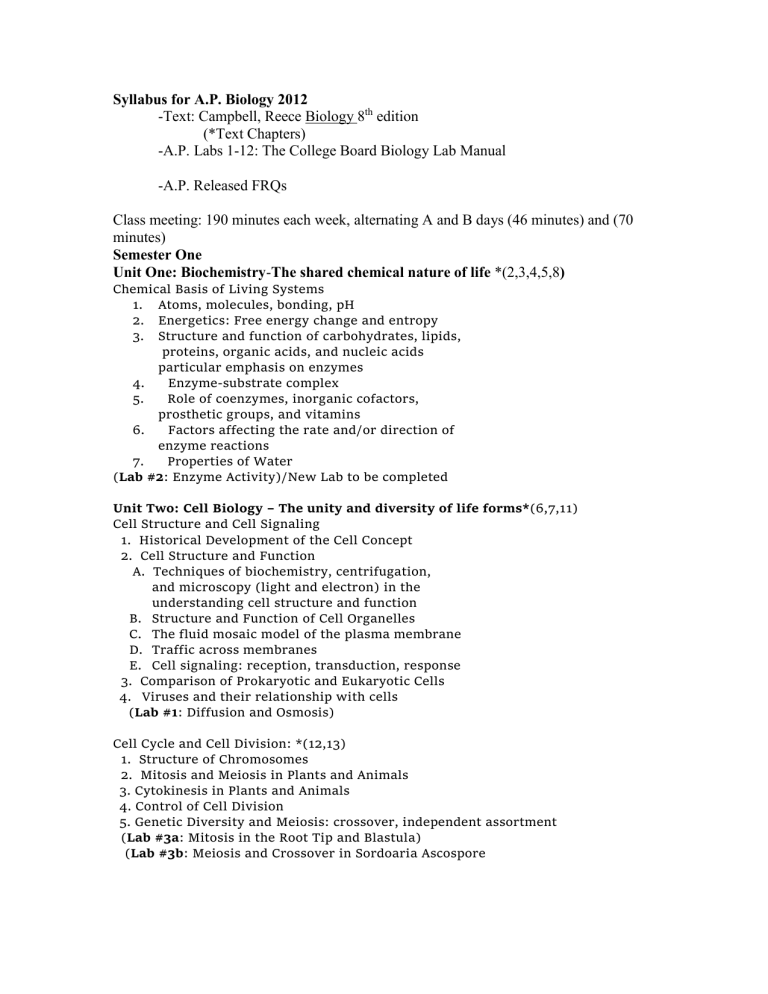
Syllabus for A.P. Biology 2012
-Text: Campbell, Reece Biology 8
th
edition
(*Text Chapters)
-A.P. Labs 1-12: The College Board Biology Lab Manual
-A.P. Released FRQs
Class meeting: 190 minutes each week, alternating A and B days (46 minutes) and (70 minutes)
Semester One
Unit One: Biochemistry The shared chemical nature of life *(2,3,4,5,8 )
Chemical Basis of Living Systems
1. Atoms, molecules, bonding, pH
2. Energetics: Free energy change and entropy
3. Structure and function of carbohydrates, lipids,
proteins, organic acids, and nucleic acids particular emphasis on enzymes
4. Enzyme-substrate complex
5. Role of coenzymes, inorganic cofactors,
prosthetic groups, and vitamins
6. Factors affecting the rate and/or direction of
enzyme reactions
7. Properties of Water
(Lab #2: Enzyme Activity)/New Lab to be completed
Unit Two: Cell Biology – The unity and diversity of life forms*(6,7,11)
Cell Structure and Cell Signaling
1. Historical Development of the Cell Concept
2. Cell Structure and Function
A. Techniques of biochemistry, centrifugation,
and microscopy (light and electron) in the
understanding cell structure and function
B.
Structure and Function of Cell Organelles
C.
The fluid mosaic model of the plasma membrane
D.
Traffic across membranes
E.
Cell signaling: reception, transduction, response
3. Comparison of Prokaryotic and Eukaryotic Cells
4.
Viruses and their relationship with cells
(Lab #1: Diffusion and Osmosis)
Cell Cycle and Cell Division: *(12,13)
1. Structure of Chromosomes
2. Mitosis and Meiosis in Plants and Animals
3. Cytokinesis in Plants and Animals
4. Control of Cell Division
5. Genetic Diversity and Meiosis: crossover, independent assortment
(Lab #3a: Mitosis in the Root Tip and Blastula)
(Lab #3b: Meiosis and Crossover in Sordoaria Ascospore
Supplemental Lab: Microscopy- Examination of cell structure of root and microscopic measurement techniques
Unit Three: Energetics: Energy production for cellular work
Cellular Respiration- ATP formation *(8,9)
Energy Transformation in Cells: Anaerobic and Aerobic Respiration
A. Chemical structure and function of ATP
1) Energy transfer
2) Coupled reactions
3) Chemiosmosis
B. Pathways of anaerobic respiration
1) Glycolysis
2) Fermentation
C. Pathways of aerobic respiration
1) Krebs cycle
2) Electron transport system
D. Sites of respiratory enzymes
E. Factors affecting the rate of respiration
(Lab #5: Respiration and Germinating Peas)
Photosynthesis: Feeding the World (10)
Harvesting Energy:
a. Factors affecting the rate of photosynthesis
b. Role of pigments and plastids
c. Absorption spectra and action spectra
d. Nature and interrelation of Photo System II, Photo System I and Calvin Cycle
e. Comparison of C3, C4, and CAM pathways
f. Comparison between respiration and photosynthesis
(Lab #4: Plant Pigment Chromatography; DPIP reduction)
Supplemental Lab: Microscopy- A study of C3 and C4 leaf structure in cross-section
Unit Four: Molecular Biology
DNA-Cellular Control and Maintenance
The Chemical Nature of the Gene *(16,17,18,19,20,21)
A. Science as Process leading to the Watson-Crick Model of Nucleic Acids
B. Replication of DNA molecule
C. Genetic code and chemical nature of mutation
D. Control of protein synthesis:
Transcription, translation, translocation, mutation
E. Recombinant DNA techniques, PCR, Gel Electrophoresis, Southern Blot
F. Gene regulation:
structural and regulatory genes
G.
Genetics of Bacteria: Principles of transformation, transduction and conjugation
H.
Genetics of Viruses: A Borrowed Life
I.
The lac and trp operon
J.
Eukaryotic Gene Expression
K.
Genetics of Development and the Hox genes
(Lab #6a: Molecular Biology and Gel Electrophoresis using lambda DNA;
(Lab #6b: Transformation of ampicillin resistance using E.Coli and Puc8)
Supplemental Lab: Affects of Mutation of Protein Synthesis
Genetics *(14,15)
Inheritance of Favorable Traits
1. Mendelian inheritance: dominance, segregation,
independent assortment
2. Probability and outcome
3. Chromosomal basis of inheritance
a. Parallel behavior of genes and chromosomes
b. Sex determination
c. Chromosomal abnormalities
d. Autosomal linkage and sex linkage
4. Epistasis
5. Polygenic Inheritance
6. Multiple alleles, human blood groups
7. Human genetic defects
(Lab #7: Genetics of Organisms; Drosophila)
(Lab #7b: Chi-Square Analysis)
Unit Five- Change over Time- The environment and allele fluctuations over time
Evolution- the force that drives the unity and diversity of life *(22, 23,24)
1.
Darwin-Wallace Theory and it’s Predecessors
2.
Modern Concepts of Natural Selection a. directional, stabilizing, disruptive
3.
Population Genetics
4.
Allele frequencies a.
Hardy-Weinberg Equilibrium b.
Mutation c.
Genetic drift d.
Gene flow e.
Polymorphism f.
Selection pressures
5.
Speciation a.
allopatric b.
sympatric c.
adaptive radiation
6. Punctuated Equilibrium and gradualism
(Lab #8: Population Genetics)
(Supplemental lab: Evolution of the Modern Horse taken from BSCS-green version
Film: Why Sex? WGBH Boston Video
Semester Exam
100 Released A.P. Multiple Choice Questions
Two Essays from released exams
Semester Two
Origin of Life *(25)
1.
An overview of the geological time scale
2.
Fossil record
3.
Life’s History a.
prokaryotes b.
oxygen revolution c.
eukaryotic life d.
multicellularity e.
animal diversity
(Lab: Microscopy- a study of Cyanobacteria
(Lab: Camincules and Cladogram formation)
Classification/Phylogeny *(26,27,28,31,32,33,34)
Systematics: Connecting Classification to Phylogeny
1.
Prokarytotes and origin of metabolic diversity
2.
The diversity of the Protists
3.
Diversity and ecological impact of the Fungus
4.
Animal Evolution a.
The Invertebrates b.
The Vertebrates
The Amniotic Egg
(Lab Practical: Animal Classification)
(Lab Practical: Classification of prokaryotes and Protists, and Fungus)
Animal Form and Function *(40,41,42,43,44,45,48,49,50)
Structure and Function with an emphasis on vertebrates
1.
Homeostasis and regulating the internal environment
2.
Histology- a study of tissues
3.
Animal Nutrition, Gas Exchange and Circulation
4.
Immunity and Endocrinology
5.
Thermoregulation, Osmoregulation and Filtration
6.
Nervous Systems
7.
Sensory and Motor Mechanisms
(Lab #10: Circulatory Physiology)
(Lab Practical: Comparative Histology)
(Fetal Pig Dissection)
(Eye Dissection)
Animal Reproduction and Embryology* (46,47)
1. Reproductive Strategies a.
parthenogenesis b.
asexual reproduction c.
sexual reproduction d.
oviviporous, viviparous, ovoviviporous
2. . Male and Female Reproductive Anatomy and Physiology
3.. Pregnancy
4. Comparitive embryology- starfish, frog, chick, mammal
5.
Fertilization, cleavage, gastrulation, germ layers and their derivatives
6.
Induction, determination, and differentiation
(Lab: Microscopy of chick and frog development)
Film: Miracle of Life
Animal Behavior *(51)
Principles of Behavior
1. Stereotyped and Learned Behavior
2. Biorhythms
3. Societies: social insects, birds, and primates
4. Social Behavior
A. Communication and signals
B. Dominance Hierarchy
C. Territoriality
D. Aggression
E. Courtship
F. Parental Behavior
(Lab #11: Isopods and Choice Chambers)
Plant Structure/Function* (29,30,35,36,37,39)
1.Evolution of Land Plants
Bryophytes, Pterophytes, Gymnosperms, Angiosperms
2. Plant Systems tissues- sclerenchyma, parenchyma, cholenchyma
Root, stem, leaf- cross-section anatomy
Water and mineral absorption and transportation
Translocation and storage
Tropism and photoperiodicity
(Lab *9: Transpiration)
(Lab: Microscopy of the Leaf, Root, Stem)
(Lab Practical: Plant Phyla- Bryophytes, Pterophytes, Gymnosperms, Angiosperms)
Plant Reproduction *(38)
Plant Reproduction and Development
1. Alternation of generations in moss, fern, pine,
and flowering plants
2. Spore and gamete formation
3. Fertilization and sporophyte formation
Seed structure and germination
4. Growth and development: hormonal control
(Lab: Dissection of the Flower)
Ecology* (50,52,53,54,55)
1.
Habitat a.
abiotic factors: chemical and physical b.
biotic factors: species interactions
2.
Population growth and regulation a. life history, fecundity, survivorship, mortality, age structure b. densityl-dependent and density independent factors
3.
Community structure, growth and regulation a. succession and climax communities
b. major biomes
4.
Energy flow and productivity in a.
Food chains and webs
b. trophic levels and pyramids
c. primary and secondary productivity
5. Biogeochemical cycles
(Lab #12: Dissolved Oxygen)
(Lab: Biomes-comparative abiotic factors)
Semester Exam
100 Multiple Choice questions from released exams
4 Essays from released exams
Teaching Strategiies
The biology curriculum is presented through a lens designed to incorporate the AP Biology course description, the Campbell Reece themes used to connect concepts of biology, and the Clayton Science Enduring Understandings.
AP- Science as process, evolution, energy transfer, continuity and change, structure and function, regulation, interdependence and science, technology and nature.
Campbell Reece: Emergent properties, structure and function, interaction with the environment, evolution, unity and diversity, evolution, scientific nquiry, science technology and society
Clayton Science: The systematic nature of all things, the interaction of energy and matter that flow through systems, the nature of change and equilibrum, the relationship between structures and functions, the nteractions between science and society, the creation of models to represaent absatract ideas and phenomena, the process of scientific reasoning and evalution of ideas.
Student Evaluation
A.P. Biology grades are weighted: tests (55%), lab (L35%) problem sets (10%).
Final Exams are 20% of the semester grade.
Lab Component:
Students complete the 12 AP Board labs, and have supplementary lab work throughout the year. Students work with a partner, and complete a full lab report that is kept in a portfolio. Labs are completed on A days (every other day) for 70 minutes.
